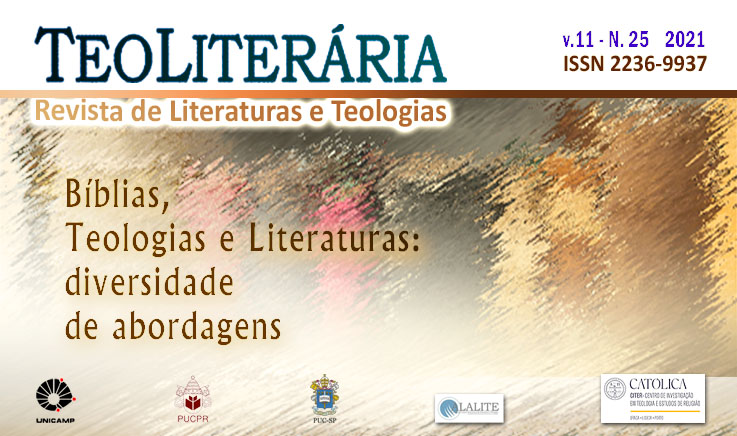Meditación y mística en “East Coker” de T.S. Eliot
DOI:
https://doi.org/10.23925/2236-9937.2021v25p222-248Palavras-chave:
T.S. Eliot, East Coker, poesía meditativa, meditación, místicaResumo
El presente artículo consiste en un análisis interpretativo de “East Coker” como poema meditativo. Se describen las características esenciales de dicho subgénero híbrido y se muestra cómo —con qué temas y recursos estilísticos— el poeta configura concretamente una búsqueda trascendente de la Divinidad en el poema. Se descubre que la búsqueda se realiza al modo de una meditación ascético-espiritual con características definidas que invitan al lector a involucrarse en el movimiento meditativo. Así, este es capaz de realizar performativamente la misma meditación, que se convierte en un verdadero ejercicio espiritual.
Referências
Biblia de Jerusalén. Bilbao: Desclée de Brouwer, 1998.
AL-DOURI, Hamdi Hameed. T. S. Eliot’s Four Quartets and St. John of the Cross. Journal of Language Studies, vol. 2, n. 3, 2019: 1-20.
ELIOT, T. S. Cuatro cuartetos. Ed. bilingüe de Esteban Pujals. Madrid: Cátedra, 2006.
GONZÁLEZ-DEGETAU, Alejandro. La via negationis en san Juan de la Cruz y Rainer Maria Rilke. Hipogrifo, vol. 6, n. 2, 2018: 429-442.
GORDON, Lyndall. «What Might Have Been and What Has Been»: How T. S. Eliot Looked at Lives. The Hudson Review, vol. 6, n. 4, 2015: 573-581.
HOWARTH, Herbert. Eliot, Beethoven, and J. W. N. Sullivan. Comparative Literature, vol. 9, n. 4, 1957: 322-332.
JUAN DE LA CRUZ, san. Obras completas. Burgos: Monte Carmelo, 2003.
MATTHIESSEN, Francis Otto. Eliot’s Quartets. The Kenyon Review, vol. 5, n. 2, 1943: 161-178.
MCMAHON, Robert. Understanding the Medieval Meditative Ascent. Washington D.C.: The Catholic University of America Press, 2006.
MURPHY, Russell Elliott. Critical Companion to T. S. Eliot: A Literary Reference to His Life and Work. New York: Facts On File, Inc., 2007.
MURRAY, Paul. T. S. Eliot and Mysticism. Londres: Palgrave Macmillan, 1991.
SCHMELZER, Felix. T. S. Eliot and the Tradition of Christian Mysticism: The Spatial Paradox in Burnt Norton. Teoliterária, vol. 7, n. 14, 2017: 55-69.
SHARP, Corona. ‘The Unheard Music’: T. S. Eliot’s Four Quartets and John of the Cross. University of Toronto Quarterly, vol. 51, n. 3, 1982: 264-278.
SPURR, Barry. Anglo-Catholicism and the «Religious Turn» in Eliot’s Poetry. Religion and Literature, vol. 44, n. 1, 2012: 136-143.
SWEENEY, James Johnson. East Coker: A Reading. En: BERGONZI, Bernard. T. S. Eliot’s Four Quartets: A Casebook. Londres: The Macmillan Press Ltd., 1969.
WAGNER, Robert D. The Meaning of Eliot’s Rose-Garden. Modern Language Association, vol. 69, n. 1, 1954: 22-33.
ZAMBRANO CARBALLO, Pablo. Eliot entre Conrad y Dante: Un Comentario sobre el Tópico del ‘Cruce de Miradas. En: PÉREZ GUERRA, Javier; CANEDA CABRERA, M. Teresa. Proceedings of the XIXth International Conference of AEDEAN. Vigo: Universidade de Vigo, 1996b, p. 597-600.
ZAMBRANO CARBALLO, Pablo. Paz, Borges, Eliot: tres recreaciones del eterno retorno. En: GÓMEZ CARRASCO, Luis María. Las formas del mito en las literaturas hispánicas del siglo XX. Huelva: Universidad de Huelva, 1994, p. 181-202.
ZAMBRANO CARBALLO, Pablo. La mística de la noche oscura: San Juan de la Cruz y T. S. Eliot. Huelva: Universidad, 1996a.
Publicado
Como Citar
Edição
Seção
Licença
Copyright (c) 2021 TEOLITERARIA - Revista de Literaturas e Teologias

Este trabalho está licenciado sob uma licença Creative Commons Attribution 4.0 International License.
A TeoLiterária – Revista de Literaturas e Teologias é detentora dos direitos autorais de todos os artigos publicados por ela. A reprodução total dos textos em outras publicações, ou para qualquer outro fim, por quaisquer meios, requer autorização por escrito do editor. Reproduções parciais de artigos (resumo, abstract, mais de 500 palavras de texto, tabelas, figuras e outras ilustrações) deverão ter permissão por escrito do editor e dos autores.



